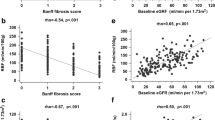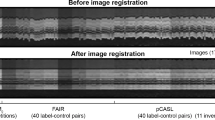Abstract
Objective
To quantify renal allograft perfusion in recipients with stable allograft function and acute decrease in allograft function using nonenhanced flow-sensitive alternating inversion recovery (FAIR)-TrueFISP arterial spin labeling (ASL) MR imaging.
Methods
Following approval of the local ethics committee, 20 renal allograft recipients were included in this study. ASL perfusion measurement and an anatomical T2-weighted single-shot fast spin-echo (HASTE) sequence were performed on a 1.5-T scanner (Magnetom Avanto, Siemens, Erlangen, Germany). T2-weighted MR urography was performed in patients with suspected ureteral obstruction. Patients were assigned to three groups: group a, 6 patients with stable allograft function over the previous 4 months; group b, 7 patients with good allograft function who underwent transplantation during the previous 3 weeks; group c, 7 allograft recipients with an acute deterioration of renal function.
Results
Mean cortical perfusion values were 304.8 ± 34.4, 296.5 ± 44.1, and 181.9 ± 53.4 mg/100 ml/min for groups a, b and c, respectively. Reduction in cortical perfusion in group c was statistically significant.
Conclusion
Our results indicate that ASL is a promising technique for nonenhanced quantification of cortical perfusion of renal allografts. Further studies are required to determine the clinical value of ASL for monitoring renal allograft recipients.




Similar content being viewed by others
Abbreviations
- MRI:
-
magnetic resonance imaging
- ASL:
-
arterial spin labeling
- FAIR:
-
flow-sensitive alternating inversion recovery
- TRAS:
-
transplant renal artery stenosis
- BOLD:
-
blood oxygenation level-dependent
- DWI:
-
diffusion-weighted imaging
- ADC:
-
apparent diffusion coefficient
- NSF:
-
nephrogenic systemic fibrosis
- FOV:
-
field of view
- ROI:
-
region of interest
- RF:
-
radiofrequency
- TI:
-
inversion time
- MRU:
-
MR urography
- ATN:
-
acute tubular necrosis
- GFR:
-
glomerular filtration ratio
- EPI:
-
echo-planar imaging
References
Leichtman AB, Cohen D, Keith D et al (2008) Kidney and pancreas transplantation in the United States, 1997–2006: the HRSA breakthrough collaboratives and the 58 DSA challenge. Am J Transplant 8:946–957
Baxter GM (2001) Pictorial review: ultrasound of renal transplantation. Clin Radiol 56:802–818
Lanzman RS, Voiculescu A, Walther C et al (2009) ECG-gated nonenhanced 3D steady-state free precession (SSFP) MR angiography (MRA) in assessment of transplant renal arteries: comparison with digital substraction angiography (DSA). Radiology 252:914–921
Blondin D, Koester A, Andersen K, Kurz KD, Moedder U, Cohnen M (2009) Renal transplant failure due to urological complications: comparison of static fluid with contrast-enhanced magnetic resonance urography. Eur J Radiol 69:300–307
Sadowski EA, Fain SB, Alford SK et al (2005) Assessment of acute renal transplant rejection with blood oxygen level-dependent MR imaging: initial experience. Radiology 236:911–919
Thoeny HC, Zumstein D, Simon-Zoula S et al (2006) Functional evaluation of transplanted kidneys with diffusion-weighted and BOLD MR imaging: initial experience. Radiology 241:812–821
Beckmann M, Joergensen J, Bruttel K, Rudin M, Schuurman HJ (1996) Magnetic resonance imaging for the evaluation of rejection of kidney allograft in the rat. Transplant Int 9:175–183
Schuurman HJ, Beckmann N, Briner U, Bruns C, Bruttel K, Tanner M, Tolcsvai L, Weckbecker G (1996) Magnetic resonance imaging in assessment of rejection of a kidney allograft in the rat: effect of the somatostatin analogue SMS 201–995. Transplant Proc 28:3272–3275
Szolar DH, Preidler K, Ebner F et al (1997) Functional magnetic resonance imaging of human renal allografts during the post-transplant period: preliminary observations. Magn Reson Imaging 15:727–735
Preidler KW, Szolar D, Schreyer H, Ebner F, Kern R, Holzer H, Horina JH (1996) Differentiation of delayed kidney graft function with gadolinium-DTPA-enhanced magnetic resonance imaging and doppler ultrasound. Invest Radiol 31:364–371
Sadowski EA, Benett LK, Chan MR (2007) Nephrogenic systemic fibrosis: risk factors and incidence estimation. Radiology 243:148–157
Golay X, Hendrikse J, Lim TC (2004) Perfusion imaging using arterial spin labeling. Top Magn Reson Imaging 15:10–27
Karger N, Biederer J, Lüsse S, Grimm J, Steffens JC, Heller M, Glüer CC (2000) Quantitation of renal perfusion with arterial spin labeling with FAIR-UFLARE. Magn Reson Imaging 18:641–647
Boss A, Martirosian P, Claussen CD, Schick F (2006) Quantitative ASL muscle perfusion imaging using a FAIR-TrueFISP technique at 3.0 T. NMR Biomed 19:125–132
Schwenzer NF, Schraml C, Martirosian P, Boss A, Claussen CD, Schick F (2008) MR measurement of blood flow in the parotid gland without contrast medium: a functional study before and after gustatory stimulation. NMR Biomed 21:598–605
Martirosian P, Klose U, Mader I, Schick F (2004) FAIR True-FISP perfusion imaging of the kidneys. Magn Reson Med 51:353–361
Huang Y, Artz N, Wen Z, Sadowski E, Fain S (2009) Measurement and comparison of T1 relaxation time in native and transplanted kidney cortex. In: Proceedings of the seventeenth meeting of the International Society for Magnetic Resonance in Medicine, Honolulu, Hawai, p 2041
Roberts DA, Detre JA, Bolinger L, Insko EK, Lenkinski RE, Pentecost MJ, Leigh JS (1995) Renal perfusion in humans: MR imaging with spin tagging of arterial water. Radiology 196:281–286
Fenchel M, Martirosian P, Langanke J et al (2006) Perfusion imaging with FAIR TrueFISP spin labeling in patients with and without renal artery stenosis: initial experience. Radiology 238:1013–1021
Hariharan S, Johnson C, Bresnahan BA, Taranto SE, McIntosh MJ, Stablein D (2000) Improved graft survival after renal transplantation in the United States, 1988 to 1996. N Engl J Med 342:605–612
Thoeny HC, Kessler TM, Simon-Zoula S, De Keyzer F, Mohaupt M, Studer UE, Vermathen P (2008) Renal oxygenation changes during acute unilateral ureteral obstruction: assessment with blood oxygen level-dependent MR imaging—initial experience. Radiology 247:754–761
Loo MH, Felsen D, Weisman S, Marion DN, Vaughan ED (1988) Pathophysiology of obstructive uropathy. World J Urol 6:53
Sheehan SJ, Moran KT, Dowsett DJ, Fitzpatrick JM (1994) Renal haemodynamics and prostaglandin synthesis in partial unilateral ureteric obstruction. Urol Res 22:279–285
Bruno S, Remuzzi G, Ruggenenti P (2004) Transplant renal artery stenosis. J Am Soc Nephrol 15:134–141
Lin YR, Wu MT, Huang TY et al (2004) Comparison of arterial spin labeling and first-pass dynamic contrast-enhanced MR imaging in the assessment of pulmonary perfusion in humans: the inflow spin-tracer saturation effect. Magn Reson Med 52:1291–1301
Warmuth C, Günther M, Zimmer C (2003) Quantification of blood flow in brain tumors: comparison of arterial spin labeling and dynamic susceptibility-weighted contrast-enhanced MR imaging. Radiology 228:523–532
Warmuth C, Nagel S, Hegemann O, Wlodarczyk W, Lüdemann L (2007) Accuracy of blood flow values determined by arterial spin labeling: a validation study in isolated porcine kidneys. J Magn Reson Imaging 26:353–358
Wang JJ, Heindrich KS, Jackson EK, Ildstad ST, Williams DS, Ho C (1998) Perfusion quantitation in transplanted rat kidney by MRI with arterial spin labeling. Kidney Int 53:1783–1791
Author information
Authors and Affiliations
Corresponding author
Rights and permissions
About this article
Cite this article
Lanzman, R.S., Wittsack, HJ., Martirosian, P. et al. Quantification of renal allograft perfusion using arterial spin labeling MRI: initial results. Eur Radiol 20, 1485–1491 (2010). https://doi.org/10.1007/s00330-009-1675-0
Received:
Accepted:
Published:
Issue Date:
DOI: https://doi.org/10.1007/s00330-009-1675-0




